#Mixed-Grass Prairie Ecosystem
Text
Broken Out of Time
A commission piece for @bloodgulchblog -- a Pilot/Chief fluff piece. This was really fun to write.
----
"Joy."
John sinks down into a crouch, hunkering further down behind the worn boulders they'd been using for cover. The elements of his HUD jitter as Joyeuse shifts attention, which he also feels in the connection between his NI and armor, which some part of him translates into fingers trying to tickle his neck. It's uncomfortable.
"Joyeuse," he says, firm. "Where'd Esparza go?"
She makes a humming sound. John takes stock of their surroundings while she plays nice with components of his armor, cycling through the various scanning functions to locate their wayward civilian.
"I thought you were watching him," she replies-- with enough grace to sound slightly abashed and guilty.
He grunts and detaches his pistol from the magclamps on his thigh.
"And I thought we were watching the birds," he returns evenly.
They were watching the birds, to be fair. Zeta Halo differed from his previous experiences on Forerunner structures in that it had a functioning… ecosystem… of sorts. With the remaining UNSC forces securing a tight foothold, he'd felt he could start relaxing his stranglehold on procedure and start-- something. Appreciating things. As it turns out, false suns feel just as warm as real ones.
"It's a little disconcerting to see birds use brass shells for mating displays," Joyeuse says. "Fernando doesn't have any proper IFF markers. I don't know…"
And he'd-- what? Relaxed enough to let a civilian sneak off into unknown territory and get himself lost? He twists around, staring intensely at his surroundings, waiting for details to seep out of the long grass and compacted dirt, like remnants of Esparza would suddenly make themselves known.
And they did-- eventually. Boot prints. Impressions of knees in the dirt. Headed further away. John carefully follows the tracks and picks his way down the rocks, closer to the thin bubbling creek that coalesces into a river in the distance. Joyeuse casts out another round of scans.
Ah.
John forgoes scaling the remainder of the terrain in favor of dropping down right behind his charge. Or, he would have, if Joyeuse didn't throw out the mental equivalent of an arm across his chest.
He freezes in place. Esparza lays prone in the grass. She highlights a handful of silhouettes. Ah.
Esparza must have snuck off to obtain a closer look at a different set of wildlife. Zeta Halo also possessed a number of rodent-like creatures (that the marines and personnel made quick work of eating). He sees them now, dipping their naked heads into the water for a drink.
Briefly, he wonders if the rings are capable of seasons. Then he shunts that thought aside and hunkers down beside Esparza.
"Hello," John intones.
Esparza jumps in his skin and bites his tongue on a yell. John stifles a surge of mixed emotions -- guilt and pride, mostly, with a tinge of amusement.
"Wear a bell," Esparza says, shaking his head.
"You snuck off first."
He blinks at John, expression scrunching up, radiating surprise.
"Guess I did."
John shifts his position in tiny increments. He doesn't want to disturb Esparza, nor does he want to disturb the animals they're watching. But this particular area has even fewer sightlines than the outcropping and it's-- rankling him, might be the word. Yeah, the sergeant uses that word a lot. Now it's in his vocabulary.
Joyeuse's good humor at the phenomena is a burst of sunlight down his spine.
"My house was on a prairie," Esparza says suddenly. "Country home. You know. So we got a lot of critters like that in the evening."
One of the rodents stands upright.
John casts back for a memory, maybe something to relate to Esparza (as he can learn to converse, Cortana would be--), and makes a listening grunt.
"My kid learned pretty quick about the circle of life though," he finishes. "Or…"
He trails off, stymied by the ground shaking seconds before the vibrations sink into the Mjolnir. Two of the rodents bolt off into the grass. The third lunges into the water and paddles determinedly to the other bank. This puts it within throwing distance of them for all of a second before it vanishes into the ground.
Joyeuse had been correct about the burrows, then.
Esparza opens his mouth and snaps it shut as the air around them rapidly shifts. A crimson Banshee roars overhead, followed by an UNSC aircraft.
"Let's move," John says.
He instinctively reaches over to Esparza, but his charge is already on his feet and retreating. More guilt and pride assaults him but he stuffs it down in favor of hurrying back to the Warthog on which they came. Joyeuse automatically switches over to friendly radio chatter and yeah-- that's contact.
Banished making a move on the local FOB.
"Can never catch a break, can we, big guy?" Esparza laughs.
John waits excruciating seconds for Esparza to buckle in before flooring it.
No, they can't. But the lulls are nice while they last. He thinks Esparza understands when their hands overlap on the shifter.
46 notes
·
View notes
Text
Day 20, Thursday, June 15: Rapid City to Scenic to Badlands National Park to Interior to Wanblee to White River to Winner to Platte to Parkston to Mitchell, South Dakota. 522 km
Rapid City is considered the gateway to the Black Hills. As I pull out of Rapid City however, I am going the other direction, towards the Badlands National Park. Located in southwestern South Dakota, the Badlands consist of 244,000 acres of sharply eroded buttes, pinnacles, and spires surrounded by a mixed-grass prairie ecosystem. The mixed grass prairie is a transitional zone between the tall-grass prairie to the east where I am headed and the short-grass prairie behind me.
It's not hard to understand where the name Badlands comes from. It is just bad land. None the less, ranchers in particular seem to find a way as even there, between the sand, the buttes and the gopher holes, I manage to spot herds of Buffalo, cattle, horses and long horn steer.
All day long, I have managed to steer clear of the Interstate by hopping from small town to small town on SD 45. Some of them, like Interior (pop 94), are too small to have much of anything, but in White River (pop 532), I find a cafe that turns out to be a bar. I order a coffee and saddle up to the bar and start conversing with the locals. The next thing I know, there is a big shot of Baileys in my coffee. Well, hello, breakfast.
As I travel further east, the farms become bigger and more prevalent, and there is a preponderance of corn. When I came this way last year at the beginning of September, the corn was seven feet high. Right now, it's about 12 inches high. That means that over the next ten weeks, it will likely grow more than six inches per week.
As I ride east, just short of Platte, I come upon the Francis Case Memorial Bridge and the Missouri River.
Unbeknownst to me, the Missouri River is the longest river in the United States. Rising in the Rocky Mountains in Southwestern Montana, the Missouri flows east and south for 2,341 miles before entering the Mississippi River north of St. Louis, Missouri. At some points, it is more than 13 miles wide. However, at my crossing point, it is less than a mile.
Pushing east, I soon hit Platte (pop 1,311) and continue on to Parkston (pop 1,544) before leaving SD 44 and turning north on SD 37 towards the Interstate and the big city lights of Mitchell (pop 15,631) where I will spend the night.
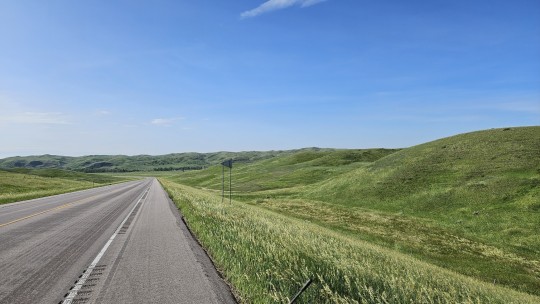

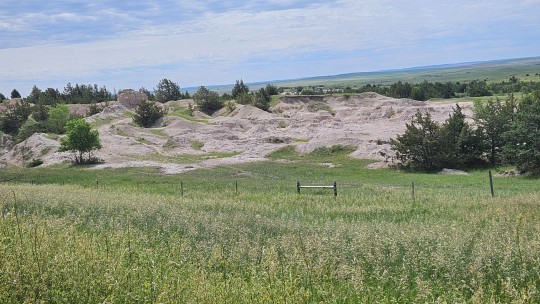


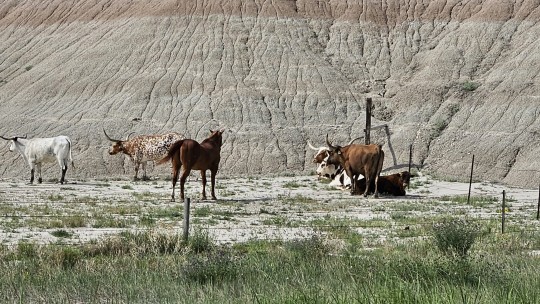
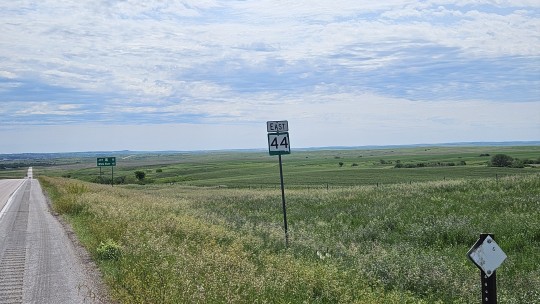

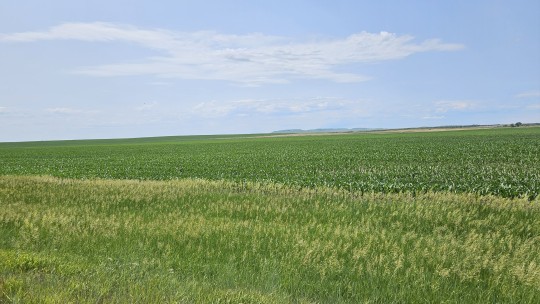
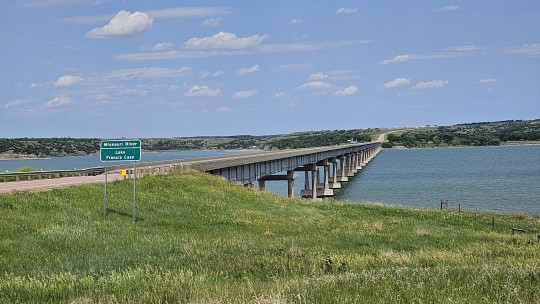
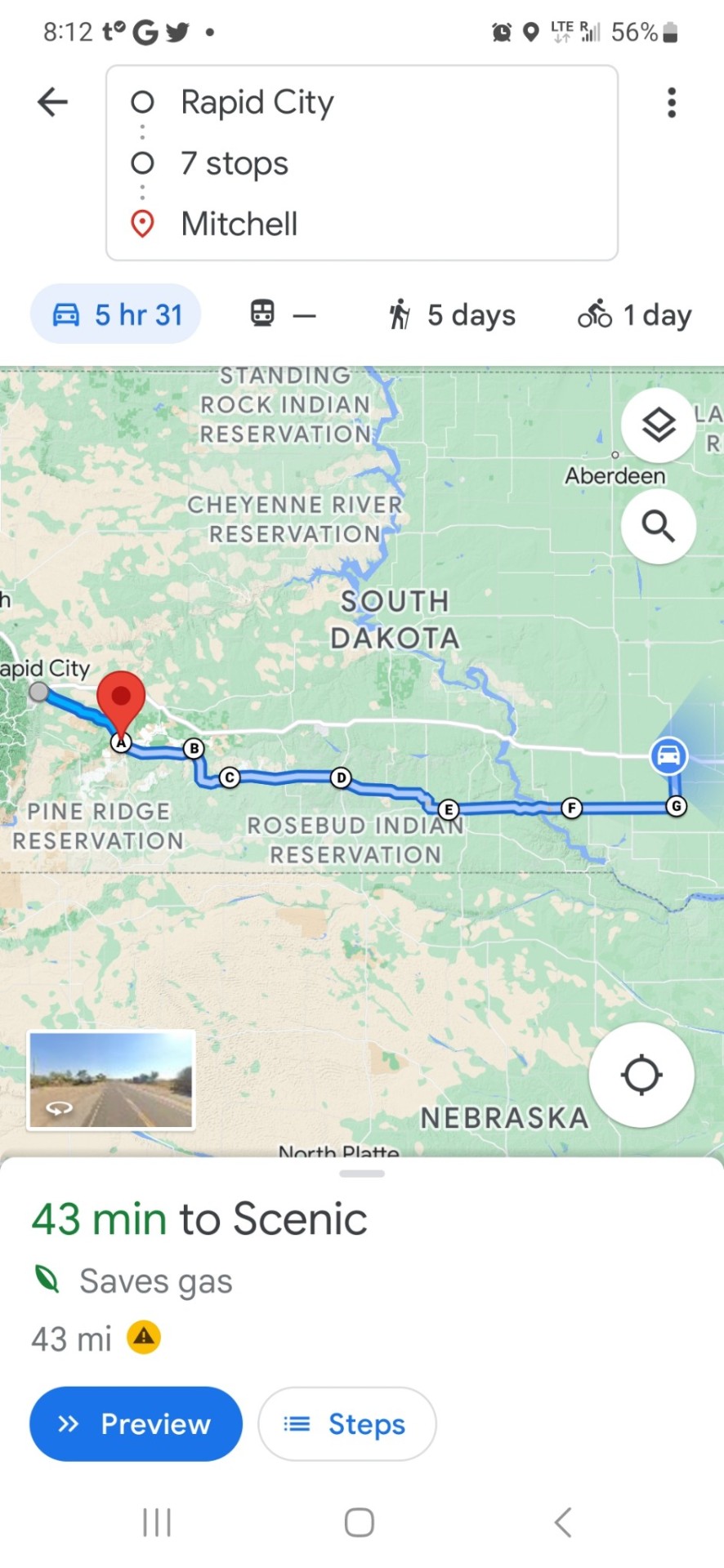
1 note
·
View note
Video
A Sweeping Bend in the Little Missouri River Across the Theodore Roosevelt National Park Landscape (Black & White) by Mark Stevens
Via Flickr:
A view looking to the southwest while walking along the Wind Canyon Trail. From this vantage point, I wanted to capture that sweeping view to the Little Missouri River flowing that seemed to best bring out the wide open landscape to my front. I later decided to make a conversion to black & white in Capture NX2 with some adjustments to color filters to bring out a more richer tonal contrast for the final image.
#Along Scenic Loop Drive#Ansel Adams Look from Capture NX2#Azimuth 205#Black & White#Blue Skies#Bluffs#Capture NX2 Edited#Color Efex Pro#Cottonwood Trees#Day 6#Grassland#Grassy Area#Grassy Field#Grassy Meadow#Great Plains#Landscape#Little Missouri River#Looking SSW#Mixed-Grass Prairie Ecosystem#Nature#Nikon D800E#North America Plains#Northern US Great Plains#Outside#Prairie Grass#Prairie Grasses#Project365#River#Riverbank#Rolling Hillsides
7 notes
·
View notes
Text
ughhhhhhhhh noooo stop it! aha! don’t release non-native earthworms in random plots of soil for enhancing gardens or free bait, don’t do it anywhere in North America lmaoooo! stop, it’s so dangerous and extremely harmful, with devastating and surprisingly dramatic and visible biome-wide effects! haha popular tumblr blogs should stop repeatedly and widely sharing advice recommending the release of non-native earthworms and calling it “anti-imperialist praxis” and “bioregional autonomy” and “vegan self-suffiency” lol! dooooon’t! it straight up destroys soil and outright kills forests :/ it directly causes death of understory plants; death of iconic species like goblin fern and serviceberry; elimination of vital fungal networks providing both soil structure and tree-to-tree nutrient-sharing; loss of native invertebrates and amphibians; savannification of the boundary between woodland and tallgrass prairie; death of red maple, sugar maple, and red oak stands; and especially harms hardwoods forests of the Great Lakes and Midwest lmao seriously stooooop it >:(

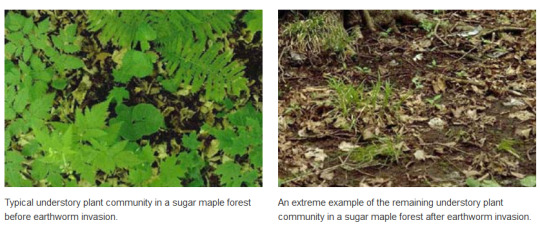
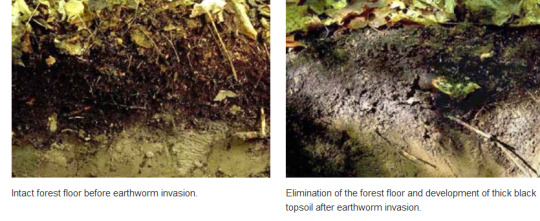
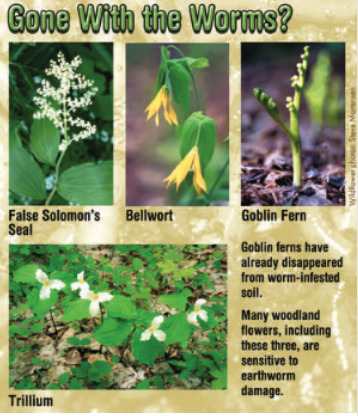

Anyway for real, I sure hope no one is deliberately releasing non-native and invasive earthworms, or bait worms, anywhere on Turtle Island/North American land, especially west of the Mississippi River or north of the Wisconsin glaciation. Earthworms and bait worms sold in stores are, by and large, not species native to the continent. They severely harm forests and soil ecology, leading directly to disruption of fungal networks; death of saplings and seedlings; death of forest understory plants; replacement of typical understory species with grasses; mortality in adult trees, as well; changes in pH; and other harm, especially devastating in northern hardwoods forests of the Great Lakes region.
Not gonna name names, but several times this year, popular blogs from the [forest-lover, anarchist/leftist/solarpunk, Moomin-fan, environmentalist-ish] realms of Tumblr have widely shared advice recommending the release of non-native earthworms or bait worms into the wild, as a form of “praxis”. I’ve got these posts screenshotted, but since I generally respect people in these circles - and in the interest of avoiding discourse and drama - I’m not going to share them. (A popular post was widely shared in February 2019; another “release store-bought earthworms” post was shared in December 2019.) I appreciate where their hearts are at. But:

Source: [x].
Some things:
From a Phys dot org summary of Great Lakes Worm Watch:
"The western Great Lakes region, which is the area we're focused on, has no native earthworms," says ecologist Cindy Hale, a research associate with the Natural Resources Research Institute at the University of Minnesota in Duluth. Native earthworms in the region were all wiped out after the last Ice Age. The current population was brought by Europeans hundreds of years ago, (soil was often used as ballast in ships) and they’re now changing the face of local forests. Anglers are adding to the problem by dumping worms that don't end up on the end of a hook.
With support from the National Science Foundation (NSF), Hale's team created the Great Lakes Worm Watch website and outreach programs to stop the spread of non-native earthworms and to clear up the common misconception that they're harmless. [...] Earthworms may be small but when they take over a forest, the impact is dramatic. They cause the rapid incorporation of organic material into the soil, changing its structure, chemistry and nutrient dynamics. What's known as the duff layer is suddenly removed, and this duff, or decaying organic material on the forest floor, is habitat for several species of insects, spiders, small vertebrates, bacteria and fungi. It is also the primary rooting zone for most plants."What's really the biggest negative effect on the plants directly is the removal of their rooting zone. It can cause mortality of adult plants but, furthermore, it can cause a loss of reproductive potential. A lot of these native plants have seeds that have very complex seed dormancy and germination strategies," says Hale.
--

Caption by Shireen Gonzaga for EarthSky: “A forest understory with a high diversity of native plants, the result when there are no earthworms in the soil. Image courtesy of Paul Ojanen.”
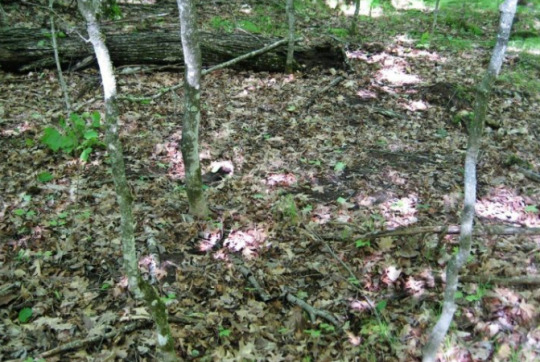
Caption by Shireen Gonzaga for EarthSky: “Forest soil with an abundance of non-native earthworms can result in a bare understory. Image courtesy of Scott L Loss.”
Non-native worms disrupt fungi networks, alter soil pH, damage seedlings, and allow grasses to gain stronger footholds to replace native/natural forest understory plants (from an EarthSky review of 2016 research by German Centre for Integrative Biodiversity Research):
Bottom line: European earthworms, introduced by early settlers, are changing the physical and chemical characteristics of soil in northern North American forests, creating a decreased diversity in native plants. [...] At the top soil layer, earthworms convert fallen leaves to humus. That’s a good thing if you’re growing a garden, but, in a natural forest, it causes a fast-tracking of the release of nutrients instead of allowing the leaf litter to break down more slowly, as it would without the earthworms.
Also, as they burrow through the ground, earthworms disrupt the mutually beneficial symbiotic relationship between fungi and plants. Some deep-burrowing worm species change the pH of upper soil layers by mixing in alkaline soil from deeper in the ground. [...]
All of these changes adversely affect native plants that did not evolve in such conditions. For instance, the goblin fern is rarely found in areas with high earthworm density. Other native plants facing threats include largeflower bellwort, trillium and Solomon’s seal. Earthworms also consume the seeds and seedlings of some plant species, influencing what grows in the forest understory.
In some locations, grasses, with their fine root systems that quickly absorb nutrients, dominate the forest floor. Non-native invasive plants that evolved in soils containing earthworms gain an even stronger foothold in these forests.
--
Cindy Hale, the prominent University of Minnesota-based researcher of non-native earthworms in the Great Lakes region, has published this book through Kollath-Stensaas Publishing:
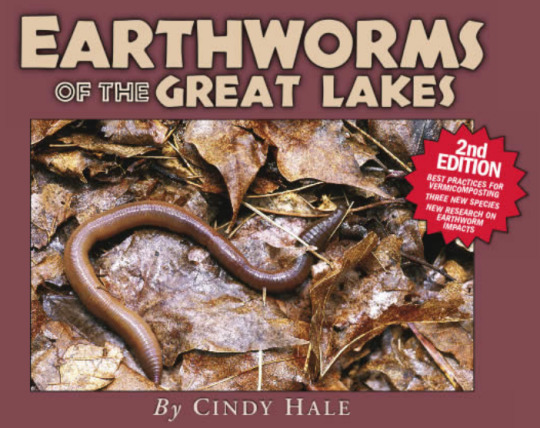

--
Non-native worms harm birch trees specifically and hardwood forests generally (excerpt from University of Toronto research, 2016):
The worms can cause dramatic changes to ecosystems by altering soils, reducing leaf litter and disrupting microbial interactions, which reduces biodiversity. Now it seems they are also eating plant seeds in the wild, potentially altering the make-up of forest communities. (…)
“They eat a lot more seeds than we think,” says Cassin [ecologist at University of Toronto in Mississauga], now at the Ontario Invasive Plant Council in Canada.
The study shows another way that earthworms can alter forest ecosystems, particularly for small-seeded species such as birch, says Lee Frelich, an ecologist at the University of Minnesota in St Paul. (…)
Once earthworms have invaded a habitat, they are almost impossible to eradicate, says Erin Bayne, of the University of Alberta in Canada. Conservationists must instead work to keep worms out of pristine habitats, he says, for example by restricting the use of worms as fishing bait and by controlling accidental transport of contaminated soil.
--
Non-native worms lead to wildflower, fern, and sapling death. In hardwood forests, this loss is probably due partially to how worms degrade the duff layer; the loss of this layer also provokes soil erosion and directly eliminates the forest floor shelter of larger invertebrates and amphibians. When saplings cannot establish themselves, there is tree loss. (From Minnesota Department of Natural Resources)
Studies conducted by the University of Minnesota and forest managers show that at least seven species are invading our hardwood forests and causing the loss of tree seedlings, wildflowers, and ferns.
--
Sugar maples, important both for forests and human food production, are devastated by the worms (from several years of research by Michigan Technological University across multiple national and state forests in the Upper Great Lakes):
A new study suggests that non-native worms are eating up the forest floor, causing sugar maples to die back and perhaps harming other forest dwellers.
Sugar maples are prized as much for their valuable lumber as for their sugary sap and dazzling fall colors. In Michigan alone, they are the basis of a multi-million-dollar industry. But several years ago, foresters began noticing that the crowns of the big trees appeared unhealthy, with bare limbs and little new growth. “They were losing trees before they could harvest them.” (…)
--
Great Lakes Worm Watch has some fun links and resources:


You can download a comprehensive key that helps identify earthworm species. Available for free, via Great Lakes Worm Watch:

Text from Great Lakes Worm Watch: “Different plant species respond to earthworm invasions differently. Some native plants appear to be very sensitive, so much so, that they can rapidly disappear when earthworms invade a forest. Some examples of these plants include…”


Worm Watch: “If earthworm invasion leads to changes in the mycorrhizal community of fungi, the diversity of plants that make up the understory would be dramatically changed. Fungi are a preferred food of many earthworm species and they graze it heavily, which could dramatically impact the abundance and composition of fungi in the soil. By grazing fungi on or near plant roots, the earthworms not only can damage the roots, but they prevent the plant and fungi from forming the symbiotic relationship where mycorrhizal fungi exchange nutrients and water for carbohydrates with green plants. If the fungi can't get enough food, they will die back even further. For some of the native plants that need mycorrhizal fungi, especially when the plant is young and small, survival will be difficult if earthworms prevent this relationship from being formed.”

-
NO MUSHROOMS
19K notes
·
View notes
Text
??Prairies??
Once upon a time, before the widespread use of the steel plow swept the nation, the vast majority of the central United States was covered in grasslands from southern Canada to central Texas.

Prairies are generally defined as grassland that has less than 11% tree coverage at any given point and can be divided up into tallgrass, mixed-grass, and shortgrass sections.
Tallgrass prairies covered a little more than the eastern third of all prairies and could be seen getting up to ten feet tall. These types of prairies were extremely grass heavy, and there would generally be a decent amount of forbs and wildflowers. Walking through one would be like swimming through grassy stalks with no way to see where you were going!
Shortgrass prairie is the other predominant prairie type and mostly occurs in the rain shadow of the Rocky Mountains. Due to far less precipitation, the grasses here get only about a foot high and have a pretty low population of forbs. This is the home of the prairie dogs and pronghorn that many people think of when they think of prairies.
Mixed-grass prairie, as you might have guessed, is a bit of both. The increase in precipitation allows for more height to the grasses, but also for a boom in forbs and wildflowers.
Each of these types of prairies added a wonderful amount of diversity to the ecosystems that they were a part of, both in terms of flora and fauna, and their rapid disappearance is a terrible loss to the biodiversity of the Great Plains of North America.
5 notes
·
View notes
Video
youtube
In many areas, more impact can be done in mcmansion hell and cookie cutter late cap façade subdivisions by convincing neighbors of the alternative to the normalized sterile lawn hell scapes. Leaving a little lawn and adding structure can still convince your neighbors subliminally that the native ecosystems are better alternatives. The gardening this OSU professor is doing is a form of prairie scaping, not reconstruction, but still beneficial. Curving paths of native short grass and path sedge, rounded bed edges, three types of upland prairies from short- tall to add a sense of dimension. This is a garden by all definitions because even the pallet and the broad cast technique is delineate. In areas where you have to fight a homeowners association this may be the best alternative obtainable and will eventually convince neighbors of it’s beauty. Eventually adding signs explaining ecosystem benefits and ecology can be added to provide additional information once the idea catches on. Signs and education are necessary to promote others to learn and explore. The signs also add a level of invitation, inviting people to use the space instead of giving them the notion of a private garden. The paths and even the lawn here are created with native seed mix still a type of monoculture but definitely more beneficial and more sustainable than sod and Europeoon lawn bull malarchy. Removing the lawn and gardening or restoring all space is obviously the most ideal situation, so I hope that this professor’s lawn has decreased in modern time.
21 notes
·
View notes
Text
City-living bees benefit most from specific types of urban ‘greening’
https://sciencespies.com/nature/city-living-bees-benefit-most-from-specific-types-of-urban-greening/
City-living bees benefit most from specific types of urban ‘greening’
Converting vacant urban lots into greenspaces can reduce blight and improve neighborhoods, and new research shows that certain types of such post-industrial reclamation efforts offer the added bonus of benefiting bees.
Ohio State University researchers studying ways to encourage biodiversity in vacant urban lots found that experimental plots surrounded by 15 or more connected acres of greenspace and flowering prairies containing native plants created conditions most conducive to the conservation of native bees and predatory wasps.
These insects are important for pollination and insect pest control, two ecosystem services that benefit both rural farmland and the growing urban agricultural industry. Estimates suggest Cleveland, Ohio, where the research was conducted, is home to over 200 community farms and gardens.
“Both urban and rural farms require pollinators for efficient crop productivity because bee visitations can enhance crop quality and quantity,” said Katie Turo, first author of the study and recent PhD graduate from Ohio State’s Department of Entomology.
Optimizing bees’ city-living conditions could also help offset threats to their diversity and survival. Bee populations are challenged by a range of stressors — habitat loss, climate change, pesticides and invasive species — that “are huge issues that aren’t going away anytime soon,” said Turo, now a postdoctoral researcher at Rutgers University.
The researchers sought to assess urban “greening” strategies that could support multiple ecosystem services provided by plants and insects, said Mary Gardiner, professor of entomology at Ohio State and senior author of the paper. And the results suggest that while infrequently mowed turf grass used for many urban greening efforts can support insects, some other types of minimally managed greenspaces could offer even more benefits to important native pollinators.
advertisement
“Even in the middle of the city, bees were using these small patches of habitat,” Gardiner said. “This is one of the first times a paper has demonstrated that native bees responded with a reproductive benefit from the establishment of native plantings within a city.”
The research is published online in the journal Conservation Biology.
This study of how greenspace quality, size and configuration affected bee and predatory wasp nesting was part of a long-term, large-scale project for which the team designed different vacant lot management styles in eight neighborhoods across Cleveland.
Among 40 of those lots, five greenspace designs were tested for effects on bee and wasp reproduction, with the existing weedy vegetation in lots mowed monthly serving as a control. Experimental treatments included a dense no-mow grass lawn, a flowering lawn of mixed grasses, a prairie of tall native grasses, and a native flowering prairie of grasses and plants.
The researchers assembled a bee and wasp trap nest composed of a series of cardboard straws at each site. Over the three-year study, Turo X-rayed each straw to count the number of larvae inside, and confirmed those counts by observing the emergence of adult bees and wasps in the spring. Of the 17 species identified, 64% were bees.
advertisement
The analysis showed that a higher abundance of native larvae was associated with the conservation plots surrounded by larger patches of additional urban greenspace — at least 15 connected acres was ideal — and more native bee larvae were observed in the flowering prairie.
In addition, native flowering prairies attracted a unique composition of bee and wasp species when compared to the control lots containing natural occurring weedy plants and turf grasses — a clue that greening urban spaces with native flowering plants could provide an important bee and wasp habitat, Turo said.
The findings could prove useful to the world’s estimated 350 “legacy” cities — former industrial hubs whose landscapes have changed dramatically as a result of lost manufacturing industries and depopulation.
A common solution to these changes has involved demolishing clusters of abandoned buildings and homes and covering over the land left behind with turf grass that needs minimal maintenance. Cleveland, for example, has lost over 50% of its population since the 1950s, leading to demolition of unneeded infrastructure and the creation of almost 4,000 acres of vacant land across 27,000 lots.
There are many community and environmental considerations at play when greening initiatives are proposed in municipalities. Despite the complexities, Gardiner and Turo said their research suggests that thoughtful conservation gives nature a chance to blossom in unexpected settings.
“This work has shown that some proportion of the bees and wasp community will respond to larger patches of greenspace being reinstituted in the landscape, even if they are not the natural habitat that was there pre-development. And I think that’s really exciting,” Gardiner said.
This work was supported by grants from the National Science Foundation, North Central Sustainable Agriculture Research and Education, and an Ohio State University College of Food, Agricultural and Environmental Sciences SEEDS grant.
#Nature
4 notes
·
View notes
Text
What is the Florida Everglades?
The Florida Everglades is a subtropical wetland that spans two million acres across South and Central Florida. It encompasses a mosaic of landscapes that include sawgrass marshes, freshwater ponds, prairies and forested highlands. The Everglades are connected by the seasonal overflow of Lake Okeechobee across the landscape into the Florida Bay leading to its dubbing as the “River of Grass”. [1, 2, 3] Landscape range illustrated below:
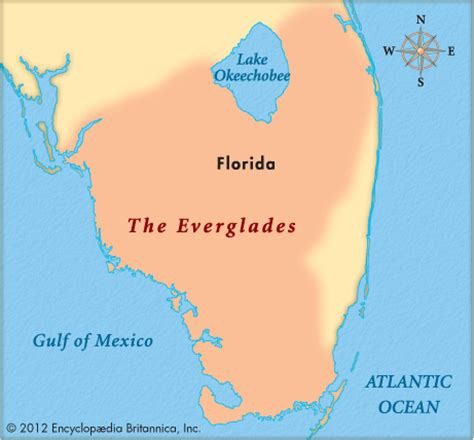
Due to the wide variety of habitats, the Everglades has a rich biodiversity with over 360 bird species alone! Unfortunately, human encroachment and pollution by urban development projects since the 1800s has led to most of the species in the Everglades being labelled as threatened, endangered or extinct. [1]
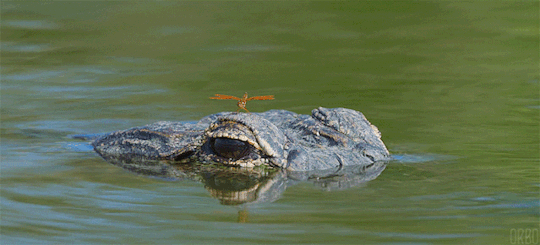
Everglade is not limited to animal diversity as it also supports a wide diversity of plant species. The unique mix of salt and freshwater give rise to a variety of wetland plant diversity from looming mangroves to a various rare and delicate orchids. [1, 2]
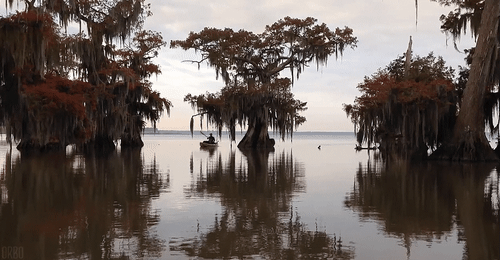
In terms of ecological services, the Florida Everglades provide a plethora of different service such as:
water filtration and irrigation [1]
flood buffer and regulation [4]
migration pathway
recreation resources (fishing, boating, swimming, etc.) [5]
ecosystem habitat
ETC.
Between the current destruction status and the range of unique environmental features, endangered biodiversity, and vital ecological services the Florida Everglades has been categorized as an endangered North American ecoregion. Recovery efforts by the cooperation of various levels of government, non-profit organizations and academic bodies are underway in an effort to rehabilitate and revitalize this crucial ecoregion.
-MOD Isabel
RB AND SPREAD AWARENESS!!!
Sources:
National Wildlife Federation. (n.d.). The Everglades.
South Florida Water Management District. (n.d.). Everglades.
World Wildlife Foundation (n.d.). Flooded Grasslands and Savannas: Everglades.
United States Environmental Protection Agency. (2015). Why are wetlands important?
U.S. National Park Service. (2020, September 9). Everglades National Park
2 notes
·
View notes
Text
Favorite Words in Horticulture
Forb
Forbs! Or Phorbs if you’re feeling kind of antiquated. This just a fun word to say, and equally fun to look at in writing. So what is it? It’s a non-woody (no trees in this guild, sorry) plant that doesn’t look like a grass.
That’s literally it and that’s why I love it. There’s absolutely no taxonomic classification or scientific methodology. It’s just dividing, say a prairie, into two groups.
Group 1: Those guys that look like grasses (they could be true grasses, or sedges, or rushes, or even isoetes)
Group 2: All these other things that aren’t trees.
Annual wildflower? Forb. Perennial rhizomatic plant? Forb. Even occasionally ferns? Forb! If it’s vascular and non-woody it counts. This, from one of our campus sites, shows a lovely mix of forbs and grasses (or graminoids).

For all that it’s a funny kind of non scientific word, I do end up using it a lot in my day to day work when we’re discussing our prairie spaces and how to keep a balanced ecosystem. It’s good shorthand that is pretty useful, especially when coordinating work.
So, if you need a way to describe landscapes in your stories, add this one to the mix!
32 notes
·
View notes
Text
Fwd: Graduate position: UWyoming.EvolutionaryEcol
Begin forwarded message: > From: [email protected] > Subject: Graduate position: UWyoming.EvolutionaryEcol > Date: 13 December 2021 at 05:42:46 GMT > To: [email protected] > > > PhD position intergrating evolutionary biology and ecological > stoichiometry > > The Wagner Lab (cewagnerlab.com) at the University of Wyoming is > recruiting a PhD student to work on integrating ideas in evolutionary > biology and ecological stoichiometry as part of the NSF-funded grant, > Stoichiometric Traits of Organisms In their Chemical Habitats (STOICH) > project (https://ift.tt/2ZSI17f). Specifically, the student will > work on topics related to the evolution and assembly of stoichiometric > traits in animal communities. We will use community datasets combined > with information about environmental and organismal stoichiometry and > phylogenetic data to better understand 1) how stoichometric traits > evolve and 2) the influence of stoichiometric traits on community > assembly processes. The student will work within the context of our > large, multi-institutional project integrating data on aquatic ecological > stoichiometric data in the STOICH database, and will be part of a diverse, > multidisciplinary team. There is considerable room for motivated students > to shape research directions based upon individual interests within > this research context. The student will work on diverse taxa, including > macroinvertebrates and fishes, with opportunity to connect with several > study systems that are the focus of work in the Wagner Lab and labs of > STOICH project collaborators. > > The Wagner Lab is committed to diversity and inclusion and particularly > welcomes applications from historically underrepresented individuals. The > University of Wyoming has strong research programs in ecology and > evolutionary biology across multiple departments, including Botany, > Zoology and Physiology, Ecosystem Science and Management, Plant > Sciences. The student will join UW's Program in Ecology and Evolution, > an interdepartmental PhD program (https://ift.tt/3rYYoex). The > university is located in Laramie, a community in southeastern Wyoming > that is nestled between the Laramie and Snowy Mountain ranges, which > offer ample opportunity for skiing, climbing, hiking, and mountain > biking. Laramie has a relatively low cost of living, is close to field > sites across a wide variety of vegetation types from mixed grass prairie > to alpine tundra, rivers and lakes, and is within easy driving distance > of Colorado's Front Range corridor (Fort Collins, Boulder, and Denver). > > To express interest in the position, please email Dr. Catherine > ("Katie") Wagner ([email protected]) with the subject line > "STOICH PhD Position" and include a CV and a brief cover letter > describing your research background and motivation for interest in > working on this project. Inquiries are welcome until the position is > filled, but applicants are encouraged to write to express interest in > the position before the end of December 2021. > > > "Catherine E. Wagner" >
via IFTTT
0 notes
Video
Prairie Grasslands Beyond the Badlands of Panorama Point (Badlands National Park) by Mark Stevens
Via Flickr:
An idea I got from another photographer with a view across some eroded landscape of badlands and prairie grasses that seemed to stretch out to a distant horizon. This is a view looking to the southeast from the main overlook.
#Azimuth 128#Badlands#Badlands National Park#Blue Skies#Blues Skies with Clouds#Brule Formation#Capture NX2 Edited#Color Efex Pro#Creek#Day 5#Eroded Buttes#Eroded Pinnacles#Great Plains#Ideas I Got From Others#Landscape#Layers of Rock#Looking SE#Mako Sica#Mixed-Grass Prairie Ecosystem#Nature#Nikon D800E#Niobara-Missouri-Black Hills Plains#North America Plains#Outside#Panorama Point#Partly Cloudy#Pierre Shale#Portfolio#Prairie Grass#Prairie Grasses
7 notes
·
View notes
Text
More on worm invasion, regarding “savannification” and why the transition zone between boreal forest and temperate woodlands near the “northern central hardwoods forest ecoregion” of Minnesota, Wisconsin, and Michigan is a critical region for minimizing the damage from the northward expansion of non-native earthworms: Since non-native worms have been seemingly omnipresent and well-established across temperate North America - for several centuries, in many places - it’s worth noting that there is still potential future damage that might be mitigated by human action against worm expansion. Apparently, non-native earthworms can contribute significantly to devegetation of boreal and mixed forest near Minnesota’s Boundary Waters region, and the expansion of tallgrass prairie and oak savanna into previously boreal climates and forested landscapes. There’s a good reason that so much earthworm ecology research is based at schools in Minnesota, Michigan, and Ontario. So here are some more horrible map abominations I made with the beloved program M!crosoft Paint (the working-class GIS, lol) regarding the danger of worms in Great Lakes, Midwest, and boreal ecosystems.

-----
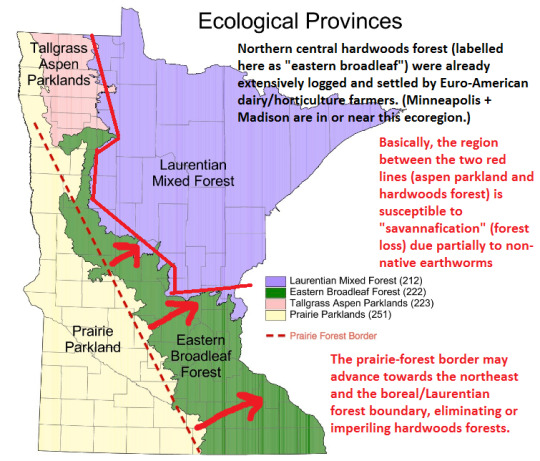
“European earthworms, principally the nightcrawler (Lumbricus terrestris), leaf worm (Lumbricus rubellus), and angleworms (Aporrectodea spp), are invading forests along the entire prairie-forest border, including boreal forests from Alberta to northern Minnesota, and hardwood forests from Minnesota to Indiana. The northern part of the prairie-forest border, from northern Wisconsin through Alberta, has no native earthworms.” [Source. An influential research paper. Lee E. Frelich and Peter B. Reich. “Will environmental changes reinforce the impact of global warming on the prairie-forest border of central North America?” Frontiers in Ecology and the Environment (2009).]
From the same article:
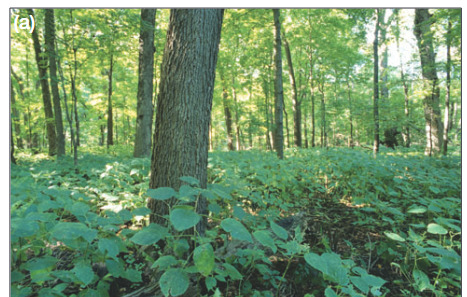

Caption, LE Frelich and PB Reich: “Forest change caused by earthworm invasion and deer grazing. (a) Intact forest of sugar maple, basswood, and red oak. (b) Forest with high deer population and earthworm invasion. Note the absence of tree seedlings, herbs, and duff on the forest floor.”
“Savannification” of North America’s northern prairie-forest border zone (in Minnesota, Manitoba, Saskatchewan, and Alberta) is soon expected to increase significantly due to the combination of climate crisis; industrial monoculture; white-tailed deer overabundance and overgrazing; and introduced exotic earthworm species. In other words, aspen parkland and northern central hardwoods forest, in the region where boreal biomes meet temperate biomes near Winnipeg, could be converted into savanna.
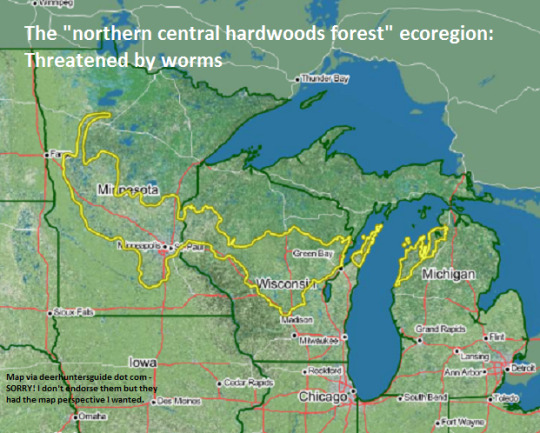
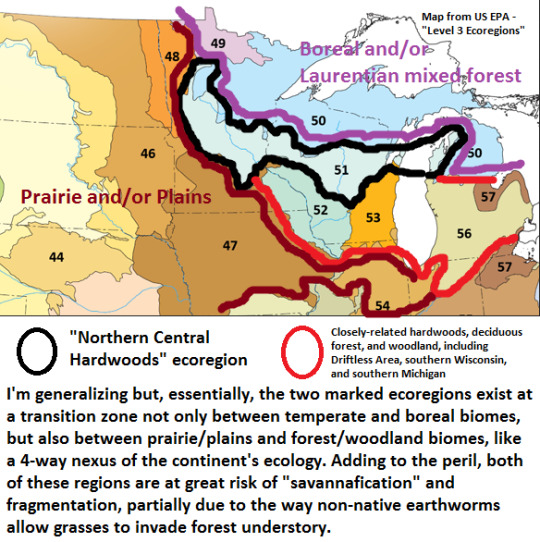
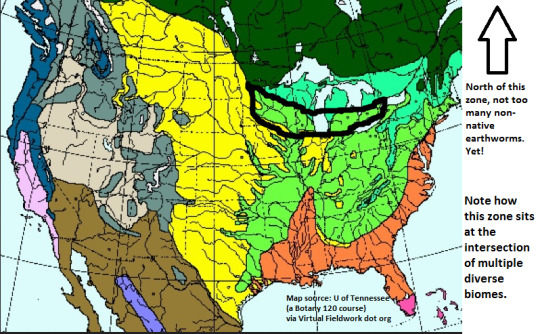

One major reason for forest loss and the encroachment of savanna is the death of the understory and forest floor of northern central hardwoods environments in Minnesota and Wisconsin; the way the non-native earthworms destroy understory plants allows the related encroachment of grasses in their place (creating a self-sustaining cycle and advancement of prairie/woodland replacing forest).
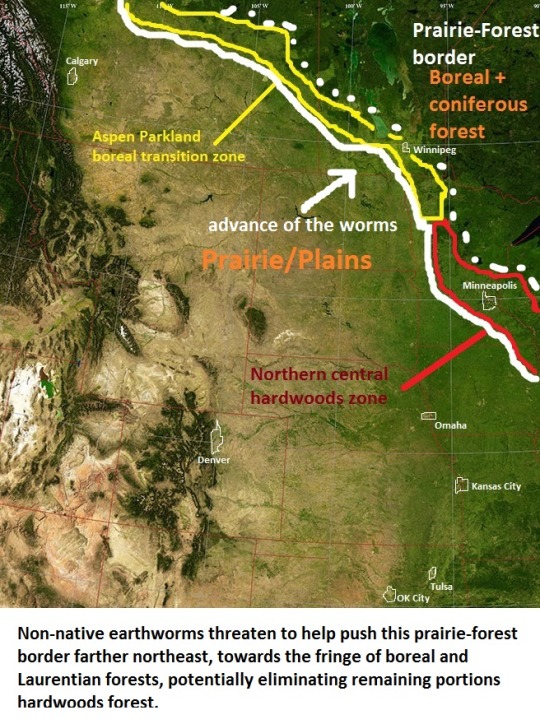
--
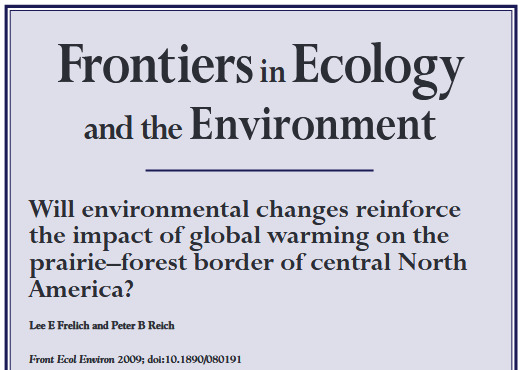
Guess I’d recommend this article, which deals with the boreal-temperate border and the prairie-forest border in Alberta, Saskatchewan, Manitoba, Minnesota, and Wisconsin.
The magic words you were waiting for:
[Free PDF]
2K notes
·
View notes
Text
Prairie Creek Conservation Cemetery: Gainesville’s eco-friendly burial site
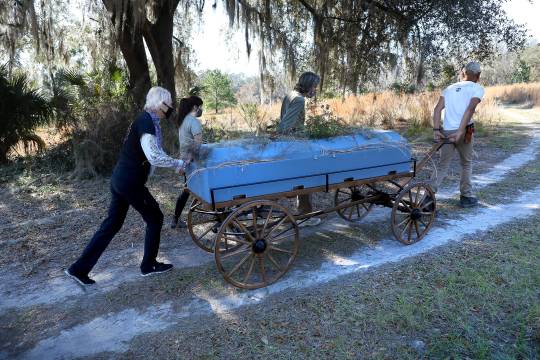
A blue cardboard casket sits in the solar, balancing on three picket slats above its remaining resting place.
Pink rose petals and tufts of golden prairie grass lay on high, gently fluttering within the breeze, as cemetery volunteers learn a poem and maintain a second of silence for the person inside. Inexperienced palm fronds, a stark distinction to the crimson, clay-filled soil that might quickly mound on high, line the underside of his grave.
The casket is lowered. The shovels are grabbed. And the intense, buzzing ecosystem welcomes the person dwelling as he returns to the earth.
Prairie Creek Conservation Cemetery is a nonprofit, Gainesville-grown conservation website and neighborhood cemetery situated off Southeast County Highway 234. It was based in 2007 by three neighborhood members — Robert “Hutch” Hutchinson, Freddie Johnson and Larry Schwandes — with the assistance of native conservation group Alachua Conservation Trust.
PCCC was licensed in July of 2010, changing into the fourth conservation burial floor within the nation.
It has since operated for nearly 11 years and holds about 700 graves with one other 1,000 individuals signed up for future area, in accordance with Johnson, govt director since 2011.

Working with the Alachua Conservation Belief, which owns the Prairie Creek Protect surrounding the cemetery, PCCC’s founders purchased a bit of what was then an undesirable, beaten-up cow pasture.
As a mix conservation and cemetery, he mentioned, its 93 acres serve to replenish native Gainesville forests and grasslands in addition to supply locals a inexpensive and eco-friendly different to society’s present funeral customary.
“In our tradition for a while, we have had this loss of life phobia,” he mentioned. “What you see here’s a pure panorama, and that is the distinction. You need to be taught loss of life as part of life.”
What’s a conservation burial floor?
Being a conservation burial floor means this: There is no such thing as a embalming allowed at Prairie Creek. Our bodies should both be buried the day of loss of life or refrigerated till the funeral could be held to stop undesirable chemical compounds from leaching into and polluting the conservation land. Ashes could be buried as effectively however not in any nonbiodegradable containers.
To permit for a standard decaying course of, he added, the lifeless can solely be buried there in cardboard, wicker or unfinished wooden caskets or shroud cloths created from pure materials like cotton. And to get to their assigned plots, our bodies are transported by way of the cemetery’s clear habitats on a picket Amish burial cart.
Un-embalmed our bodies sometimes decay in two to 4 years, however graves are usually not reused even after the land settles with the intention to hold a low sufficient density so the pure atmosphere doesn’t change into overcrowded, in accordance with Carlos Gonzalez, the cemetery’s operations coordinator.
Each shovelful of soil from a grave is hand-dug by cemetery staff, perpetually wanted volunteers who can signal as much as assist by way of Facebook and typically members of the family. It’s returned on high of the burial website, and a layer of contemporary pine straw is positioned after to assist native grasses, flowers, timber and shrubs take root as soon as the earth settles.
Graves can solely be adorned with pure supplies like wooden stumps, seashells and non-dyed flowers, Johnson mentioned. A brass marker, hand stamped by Gonzalez, is positioned final, differentiating every plot with the grave occupant’s identify and beginning and loss of life dates. He additionally provides rose petals for many burials from his private backyard.
The cemetery’s aim, Gonzalez mentioned, is to assist the land and assist individuals change into extra snug and concerned within the loss of life of their family members, be it by planning forward, leaping on board throughout the funeral course of or strolling the grounds on anniversaries.
Nature and peace at Prairie Creek
That desired peace is why households can do as a lot or as little as they need, he mentioned, and why the conservation land has an expansive path system. You may dig the grave, draw and write on the casket, decrease it within the floor, transfer the soil, plant the marker, adorn the positioning your self and are available again to go to any time.
“Any household that are not on board once they come are completely on board by the tip of it,” Johnson mentioned. “Having that intimate relationship with loss of life … it is one strategy to get them to open up.”
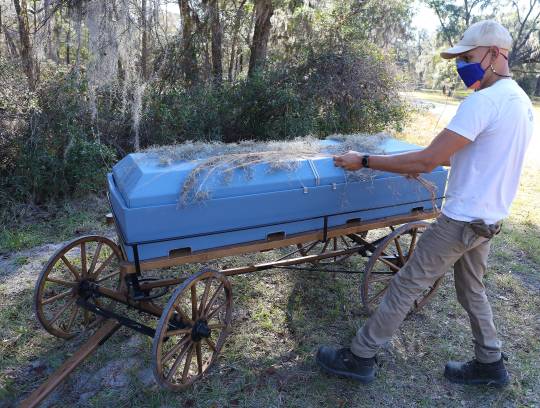
Even those that admire PCCC and select burial there early on are sometimes so entranced by the character that they let the whim of the habitat resolve what’s going to occur to their family members, he mentioned. Some households have let turkeys or sandhill cranes decide grave websites, whereas others have watched with smiles as pleasant creatures go to a tomb, nearly as in the event that they have been paying respects.
Kristie Fish, an actual property agent in Dunnellon, buried her 22-year-old son Wyatt Norman within the conservation cemetery’s meadows in November after he was killed in a automobile crash outdoors of Gainesville.
She mentioned pure burial simply felt right, and PCCC made his funeral stunning, simply the way in which she needed.
It eradicated uncomfortable photos from her overactive creativeness of her son’s physique, drained of blood and stuffed with chemical compounds, caught inside a satin lined casket and a concrete grave.
It matched her Christian perception that God made individuals from mud, and to mud individuals’s mortal our bodies return and aligned together with her son’s love for nature and choice for natural meals.
It allowed her household and buddies to be intimately concerned by digging Wyatt’s grave, stitching his burial gown, adorning his shroud with vines and flowers, inserting him within the floor and overlaying his physique with grime.
And when she visits his grave, mendacity within the golden grass beside it, Fish mentioned, she feels peace. She sees the solar that shines overhead, the crops his physique is fueling, and her thoughts is quiet.
“I know that when a cherished one dies, their physique is only a vessel, their soul is gone. However that physique is so treasured. My intuition as a mom — it felt proper to put that treasured, treasured physique deeply into the bottom and gently cowl it. It felt proper,” Fish mentioned. “It is actually my ardour that as individuals change into extra educated on this course of that increasingly individuals do it. It is simply more healthy psychologically.”
Anybody can fill out a burial preference form on-line at PCCC’s web site, prairiecreekconservationcemetery.org, and request a grave in both the woodlands or meadows on website. As soon as one member of the family is buried, spouses, youngsters and even pets can have the particular spots close by reserved to remain collectively in loss of life.
A physique burial prices $2,000, and a cremated stays burial prices $650.
Yearly, survivors can pay to have a local plant like a pine tree or Black-eyed Susan planted by their cherished one’s grave. Species and actual proximity is set by the already present atmosphere to stop overcrowding or unnatural improvement.
The cemetery’s first occupant, for instance, native doctor and environmentalist Dr. Kathy Cantwell, selected to be buried there after succumbing to mind most cancers. She has since been joined by her beloved cat, Pogie, who has lain at Cantwell’s ft since dying after her, and a magnolia tree that’s planted at her facet, Johnson mentioned.
Up till the final grave of PCCC’s roughly 4,000 plots is stuffed and the 2 cemetery habitats are again to their full well being, he mentioned, anybody else can do the identical.
Source link
source https://fikiss.net/prairie-creek-conservation-cemetery-gainesvilles-eco-friendly-burial-site/
Prairie Creek Conservation Cemetery: Gainesville’s eco-friendly burial site published first on https://fikiss.net/
from Karin Gudino https://karingudino.blogspot.com/2021/03/prairie-creek-conservation-cemetery.html
0 notes
Link
Our 62 Parks Traveler explores miles of hiking trails and one of the largest remaining mixed-grass prairie ecosystems in the country at South Dakota's Wind Cave, the 21st stop on her journey to visit every U.S. national park.
0 notes
Text
Why Prairie Dogs Are Ecological Heroes
https://sciencespies.com/nature/why-prairie-dogs-are-ecological-heroes/
Why Prairie Dogs Are Ecological Heroes
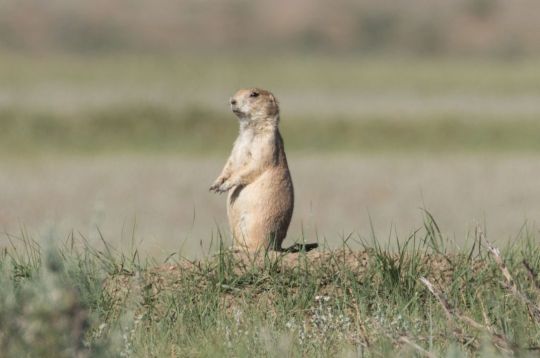
Smithsonian Voices National Zoo
Ecologists Dig Prairie Dogs, And You Should Too
July 14th, 2020, 9:30AM
/ BY
Andy Boyce and Andrew Dreelin
Varmint, gopher, keystone species, ecosystem engineer. What prairie dogs are to you depends on your point of view. Although many people view prairie dogs as pests, ecologists absolutely dig them. At our field site in north-central Montana, we’re learning more about how black-tailed prairie dogs change the landscape and support the many species that call the prairie home.

Black-tailed prairie dogs are prolific diggers and construct complex burrow systems. (Andy Boyce, Smithsonian’s National Zoo and Conservation Biology Institute)
Prairie dogs are not big and charismatic like bison, grizzly bears or pandas, but they are just as important and perhaps even more controversial. The cause for their controversy is the same reason that they are so important: these burrowing rodents make a unique and significant impact on the prairie landscape.
Prairie dogs live in huge colonies composed of countless small family groups, called coteries. They are prolific diggers, constructing complex burrow systems with specific areas for sleeping, nursing young, storing food and even disposing of their dead. A single colony’s burrow system can cover thousands of acres, with an average of about 20 prairie dogs per acre in the summer after the young emerge. That’s why these burrow systems are sometimes called prairie dog towns.
And they house more than just prairie dogs. Critically endangered black-footed ferrets eat prairie dogs (almost exclusively) and are not found outside of prairie dog towns. Desert cottontail rabbits, prairie rattlesnakes, barred tiger salamanders, plains spadefoot toads, camel spiders, innumerable insects, and other animals that can’t dig on their own also live in prairie dog burrows. Some species occupy active burrows while others, such as burrowing owls, find shelter in abandoned areas.
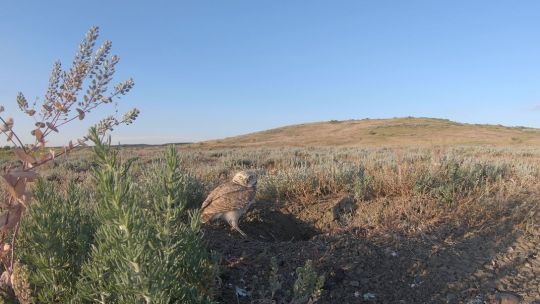
A burrowing owl stands near the entrance of a prairie dog burrow. (Smithsonian’s National Zoo and Conservation Biology Institute)
But life has been tough for prairie dogs over the last 200 years or so. Just as huge herds of bison once roamed the plains, prairie dogs used to live on enormous swaths of grassland in numbers more like cities than towns. Naturalist Vernon Bailey once described an enormous prairie dog town that in 1901 spanned nearly 25,000 square miles across central Texas and contained an estimated 400 million prairie dogs!
Prairie dogs transform the landscape through digging and grazing, and in those numbers it’s easy to see why early European colonists saw them as a destructive force. The colonization of the West led to the prairie dog’s current conservation predicament. The conversion of prairie to farms destroyed their habitat, and systematic poisonings removed colonies from land set aside for cattle. Over time, prairie dog numbers dropped by more than 95%. Their story represents more than just the loss of one species; it also accelerated the decline of the suite of species supported by prairie dog engineering.
Prairie dogs don’t only change their environment by digging burrows. With the diligence of a greenskeeper at a golf club, they also keep the lawns around their colonies neatly trimmed. They constantly graze on grasses and clip other plants to the ground, both to eat and to maintain a clear view of potential predators in all directions. When they spot a predator sneaking up — whether it’s a badger on the ground or a ferruginous hawk in the air — they immediately sound the alarm by repeatedly “yipping” to warn their neighbors about the threat.
Prairie dog landscaping incidentally creates another unique habitat for other wildlife. Birds that live in short-grass habitats often prefer prairie dog towns to similar areas without them. Some of these birds, like horned larks and long-billed curlews, are still relatively common.
Others, such as the mountain plover and McCown’s longspur, are rapidly disappearing. In fact, grassland birds are the most steeply declining group of birds in North America. Mountain plovers and McCown’s longspurs lose about 2-4% of their population each year. Could restoring prairie dogs help save them?
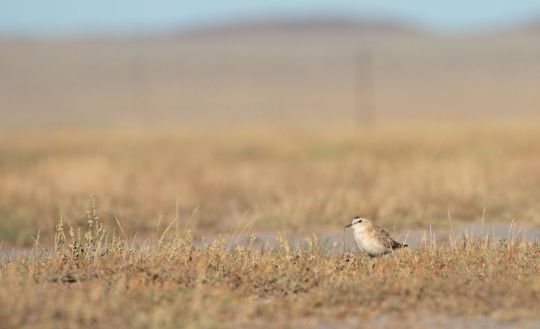
Mountain plovers, like the one pictured here, are rapidly disappearing. Could restoring prairie dogs help save these grassland birds? (Andy Boyce, Smithsonian’s National Zoo and Conservation Biology Institute)
Despite their many benefits to other grassland species, prairie dogs continue to lose ground. In the 1930s, the sylvatic plague (the same bacterium that causes the bubonic plague in humans) was accidentally introduced to prairie dogs by fleas that arrived on ships from other parts of the world. Sylvatic plague typically kills prairie dogs, because they have little resistance to the disease. Outbreaks remain widespread to this day and can wipe out entire colonies in a matter of months.
Recreational shooters also use prairie dogs as target practice, killing large numbers of the colonial rodents. Additionally, because prairie dogs eat many of the same grasses as cattle, they are still perceived as a threat and intentionally poisoned. However, the evidence that prairie dogs and cattle compete for resources is mixed.
Although prairie dogs clip and eat grasses, they also help maintain grassland habitat for cattle. Their landscaping prevents woody shrubs from taking over and can increase the nutritional quality of grass by promoting the growth of young grasses that contain extra protein and are easier to digest. Competition between prairie dogs and cattle is a hotly contested, nuanced issue, and more research is needed to understand the full picture.
Prairie dogs face an uphill battle, and although we have learned a lot about them, the story is far from complete. We know one aspect that keystone species like prairie dogs, bison and wolves share is their indirect, yet important impact on the animals around them. By studying prairie dogs at American Prairie Reserve, Fort Belknap Indian Reservation, and Charles M. Russell National Wildlife Refuge in Montana, we hope to uncover the how and why.

Bison graze on patches of grass around a prairie dog town. (Smithsonian’s National Zoo and Conservation Biology Institute)
Beyond burrowing and grazing, why do prairie dogs support so many animals? How do they influence individual species differently? By studying the animal community out here, we aim to unravel the details. For instance, do nesting birds and their chicks get a boost to their diets from the communities of insects, spiders and other arthropods that live on prairie dog towns?
If these research efforts help us understand how prairie dogs affect the species that rely on them, then conservationists and land managers across the Great Plains will be better equipped to conserve and manage prairie biodiversity — all thanks to the industrious engineering efforts of a social, burrowing rodent.
#Nature
0 notes
Text
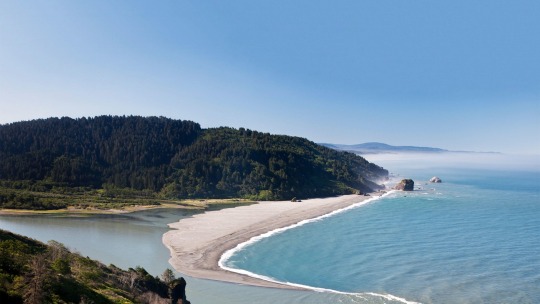
Redwood National Park! Redwood National Park is known for having some of the tallest trees in the world, but it also features oak woodlands, riverways, and coastlines that support a diverse suite of birds. As the park’s climate changes, many of the birds that we commonly see here are likely to fight suitable climate, such as the Great-Horned Owls and other owl species. But the warming climate will likely challenge other birds, including many warbler species that occur in the park, including Nashville, MacGillivray’s, Yellow-rumped, and Townsends Warblers. The park’s climate is projected to worsen for woodpecker species also, including Acorn, Red-bellied Sapsucker, Downy, and Hairy. It is recommended that managers help these and other species by emphasizing habitat restoration and reducing other stressors.
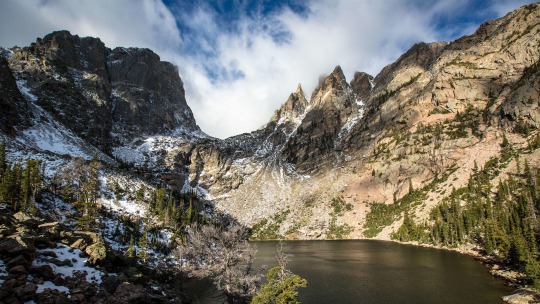
Rocky Mountain National Park! Redwood National Park is known for having some of the tallest trees in the world, but it also features oak woodlands, riverways, and coastlines that support a diverse suite of birds. As the park’s climate changes, many of the birds that we commonly see here are likely to fight suitable climate, such as the Great-Horned Owls and other owl species. But the warming climate will likely challenge other birds, including many warbler species that occur in the park, including Nashville, MacGillivray’s, Yellow-rumped, and Townsends Warblers. The park’s climate is projected to worsen for woodpecker species also, including Acorn, Red-bellied Sapsucker, Downy, and Hairy. It is recommended that managers help these and other species by emphasizing habitat restoration and reducing other stressors.

Saguaro National Park! Saguaro National Park’s two districts outside of Tucson, Arizona are characterized by water features, pine forests, and mountains to the east and protected desert vegetation to the west. Each side of the park is part of its own Important Bird Area—each a diverse ecosystem that supports the desert’s roadrunners, woodpeckers, and quails. As the climate changes, dozens of species could be extirpated from the park or face worsening conditions. These include Harris’s Hawk, Mexican Spotted Owl, and various wren species. It is recommended that park managers emphasize protecting existing habitats and reducing the effects of nonnative species.
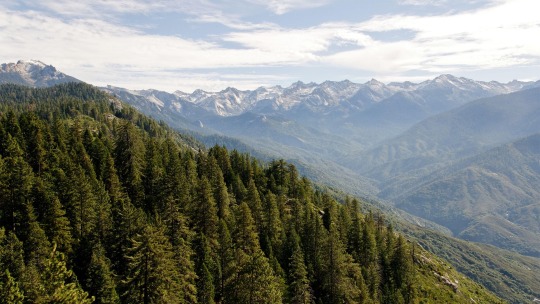
Sequoia and Kings Canyon National Parks! California's Sequoia and Kings Canyon National Parks are side by side in one of the most dramatic landscapes in the United States, home to deep forests housing the world’s largest trees. The park’s climate may worsen for Steller’s Jays and Clark’s Nutcrackers in the drier seasons to come. However, it might remain suitable for most neotropical migrants in the park, particularly warblers, such as MacGillivray's, Wilson’s, Yellow, and Common Yellowthroat. Key to maintaining bird species in these changing conditions will be preserving habitat and reducing impacts from disturbance and nonnative species

Shenandoah National Park! Forests of various types cover 95 percent of Virginia's Shenandoah National Park, and they invite a variety of birds to visit year-round—whether they breed in summer, migrate through in spring and fall, or spend the winter. As forests warm, a number of birds who breed in Shenandoah at the southern end of their range, including thrushes and warblers, might cease finding suitable climate in the park. In winter, though, the park’s climate may become suitable for 43 species, which could colonize the park. These include 11 birds, like the Common Yellowthroat and Orange-crowned Warbler, that currently breed or migrate through Shenandoah, and may choose to spend the winter, too.

Theodore Roosevelt National Park! Widely known for large mammals, such as bison, elk, and big-horned sheep, North Dakota’s Theodore Roosevelt National Park, boasts much broader biodiversity. The park can be broken down into four ecosystems—flood plains, forest, prairie/grassland, and rivers/streams—and each ecosystem hosts various birds based on the resources they provide during a particular season. Some birds call this park home year-round, such as Golden Eagles, White-breasted Nuthatches, and Great-horned Owls, which are typically found in the forested areas on the flood plain. In the spring and fall seasons, birds like White-throated Sparrows, Sandhill Cranes, and White Pelicans are found around the Little Missouri River.

Voyageurs National Park! Minnesota is one of the fastest warming states in the U.S. Its winters are becoming milder and its snowfall less consistent—and this is especially true in boreal forests like those in Voyageurs National Park. The park’s climate is likely to improve for dozens of bird species which may colonize the park from the south in summer or winter. However, Minnesota’s iconic Common Loon may find less suitable climate in the park by 2050, while other bird species could be extirpated, like Red-breasted Mergansers, Hairy Woodpeckers, Gray Jays, and a number of charismatic warblers. Park managers should track bird populations to determine priority areas for habitat management within the park.

Wind Cave National Park! America’s eighth national park, which gets its name from the sound of wind whistling through a cave opening, is located in southwestern South Dakota. The park splits into three ecosystems: ponderosa pine/aspen forests, riparian woodlands, and a mixed-grass prairie. Meadowlarks and bluebirds live on the mixed-grass prairie, while Black-backed Woodpeckers, Ovenbirds, and tanagers live in the forests.
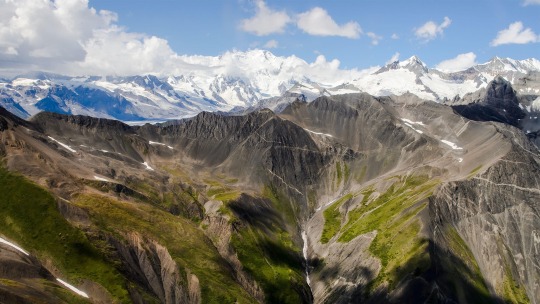
Wrangell St. Elias National Park ad Preserve! Wrangell St. Elias, America’s largest national park, is home to four major mountain ranges, the second highest peak in the U.S., one of largest active volcanoes in North America, and massive glaciers. The park’s climate could become less suitable for 32 bird species by 2050, for instance the Say’s Phoebe and Smith’s Longspur; the latter could be extirpated in the park over the coming decades. Meanwhile, the park’s climate could become more suitable for 42 species, such as the Sharp-tailed Grouse and the Red-breasted Nuthatch. It is recommended that park managers focus on monitoring programs to identify changes in bird communities.
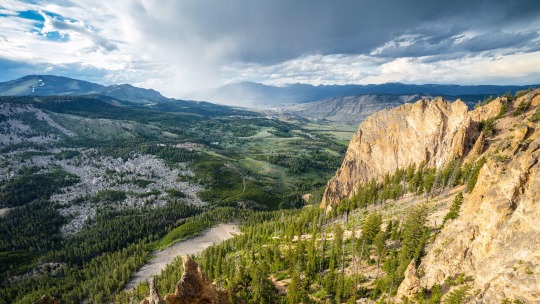
Yellowstone National Park! Yellowstone National Park is currently home to a plethora of songbird species that nest on willows growing alongside western rivers. Suitable climate is projected to persist for several of these riparian songbirds, such as the Yellow Warbler, Song Sparrow, and Willow Flycatcher, a priority species for the park. But it may grow too dry and hot for others, such as Wilson’s Warbler, Warbling Vireo, and Lincoln’s Sparrow. Because these species are willow-dependent, park managers can continue to protect natural systems—including supporting large carnivores and beavers, both of which promote healthy streamside willows beneficial to riparian songbirds.
0 notes